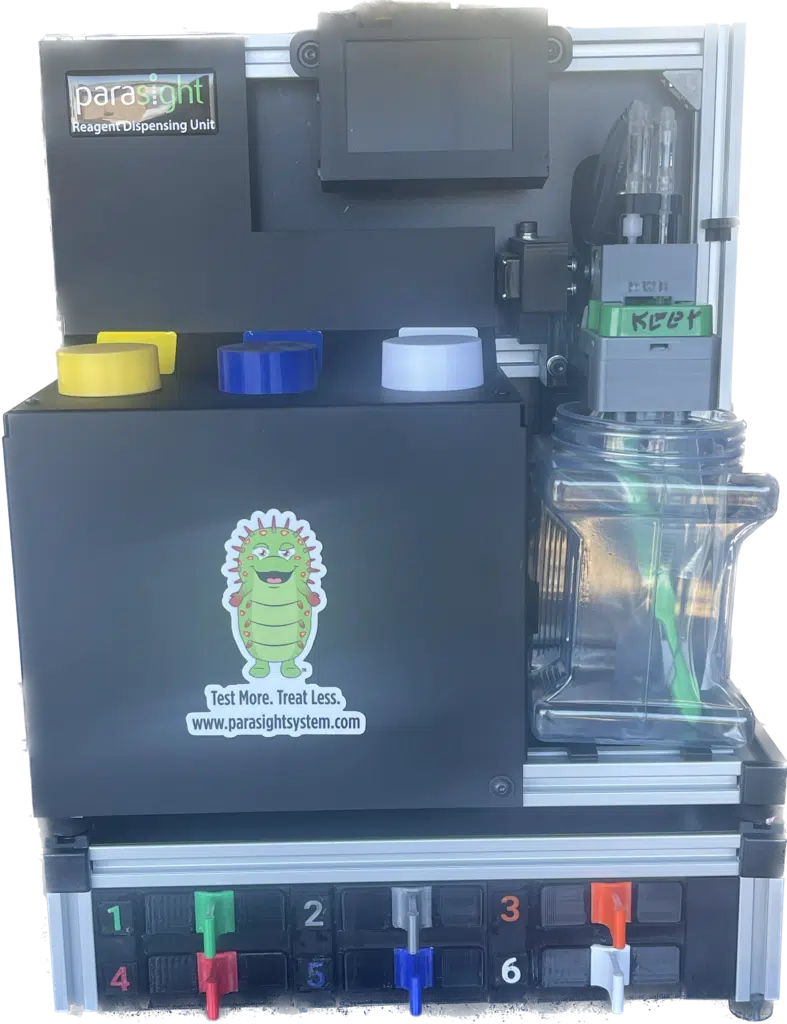5 minute test replaces McMaster and other slide technologies
Designed for in-clinic use, Parasight for sheep and goats identifies and counts round worms using an automated software counting algorithm via a 5 minute test. The Parasight System outputs an image of the parasite eggs and provides a count in eggs per gram (“EPG”). The easy-to-use Parasight App provides a simple user interface to display, email, and store results.
Sheep and goat fecal matter is unique in both density, consistency, and diet. As a result, a 2minute centrifugation in a floatation medium is required to prepare the sample. In addition, the egg chamber used for processing and imaging is unique. For clinics who use Parasight System for all three species we have things easy by color coding the test kit supplies: black egg chambers for horses and blue egg chambers for cattle, goats and sheep.
Proven to be significantly less variable and more accurate than the traditional McMaster FEC test method, the Parasight System for sheep and goat uses the same hardware system used for horses. The sample prep process and egg chamber filter are the only variances. Parasight is in use at major equine hospitals, ambulatory veterinary clinics and veterinary schools throughout the USA, Canada, and Australia.
Which parasites are detected?
Detecting Haemonchus
Haemonchus Contortus, “Barber’s Pole”, is a gastrointestinal parasite infecting small ruminants and camelids worldwide. Heavy infestation can lead to anemia, decreased production, quality of wool, edema, and mortality. Current methods of identification involve a lengthy process of larval cultivation taking up to 3 days to 2 weeks for results. Delayed results and treatment can greatly influence mortality rate. Parasight has developed a validated assay with results achieved in less than 20 minutes. Results are given in EPG for quantity of strongyle type ova; the Barber’s Pole assay results yield a percentage of Haemonchus Contortus, if positive.
The most commonly used method for detecting Haemonchus infection is coproculture, where the sample is incubated for 10 or more days to hatch the eggs and release larvae. The need for a highly trained analyst has meant that this test can only be performed at diagnostic labs with appropriately trained personnel.
Scientists at Parasight System have adapted the system’s fluorescence imaging technology to specifically detect and count Haemonchus eggs in sheep feces by using a special fluorescent dye that only stains this species of hookworm. As a result, the percentage of Haemonchus eggs in a sample can now be determined on-site in twenty minutes by operators with no technical experience whatsoever.
This research has been peer-reviewed and will soon be published in the International Journal for Parasitology, the leading research journal in this field.
(Shown Right): Parasight System at right shows the Barber’s Pole base upgrade and below a close up image of the base upgrade.
Parasight Sheep and Goats FEC instructions (PDF icon below). Please watch the video and then review the written instructions before use.

